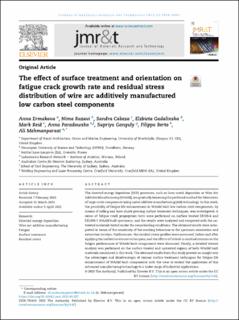| dc.contributor.author | Ermakova, Anna | |
| dc.contributor.author | Razavi, Nima | |
| dc.contributor.author | Cabeza, Sandra | |
| dc.contributor.author | Gadalinska, Elzbieta | |
| dc.contributor.author | Reid, Mark | |
| dc.contributor.author | Paradowska, Anna | |
| dc.contributor.author | Ganguly, Supriyo | |
| dc.contributor.author | Berto, Filippo | |
| dc.contributor.author | Mehmanparast, Ali | |
| dc.date.accessioned | 2023-10-02T09:06:24Z | |
| dc.date.available | 2023-10-02T09:06:24Z | |
| dc.date.created | 2023-04-20T18:54:35Z | |
| dc.date.issued | 2023 | |
| dc.identifier.citation | Journal of Materials Research and Technology (JMR&T). 2023, 24 2988-3004. | en_US |
| dc.identifier.issn | 2238-7854 | |
| dc.identifier.uri | https://hdl.handle.net/11250/3093400 | |
| dc.description.abstract | The directed energy deposition (DED) processes, such as laser metal deposition or Wire Arc Additive Manufacturing (WAAM), are gradually becoming the preferred method for fabrication of large-scale components using metal additive manufacturing (AM) technology. In this work, the possibility of fatigue life enhancement in WAAM built low carbon steel components, by means of rolling and laser shock peening surface treatment techniques, was investigated. A series of fatigue crack propagation tests were performed on surface treated ER70S-6 and ER100S-1 WAAM built specimens, and the results were analysed and compared with the untreated materials tested under the same loading conditions. The obtained results were interpreted in terms of the sensitivity of the cracking behaviour to the specimen orientation and extraction location. Furthermore, the residual stress profiles were measured, before and after applying the surface treatment techniques, and the effects of locked-in residual stresses on the fatigue performance of WAAM built components were discussed. Finally, a detailed texture analysis was performed on the surface treated and untreated regions of both WAAM built materials considered in this work. The obtained results from this study provide an insight into the advantages and disadvantages of various surface treatment techniques for fatigue life enhancement of WAAM built components with the view to extend the application of this advanced manufacturing technology to a wider range of industrial applications. | en_US |
| dc.language.iso | eng | en_US |
| dc.publisher | Elsevier B. V. | en_US |
| dc.rights | Navngivelse 4.0 Internasjonal | * |
| dc.rights.uri | http://creativecommons.org/licenses/by/4.0/deed.no | * |
| dc.title | The effect of surface treatment and orientation on fatigue crack growth rate and residual stress distribution of wire arc additively manufactured low carbon steel components | en_US |
| dc.title.alternative | The effect of surface treatment and orientation on fatigue crack growth rate and residual stress distribution of wire arc additively manufactured low carbon steel components | en_US |
| dc.type | Peer reviewed | en_US |
| dc.type | Journal article | en_US |
| dc.description.version | publishedVersion | en_US |
| dc.source.pagenumber | 2988-3004 | en_US |
| dc.source.volume | 24 | en_US |
| dc.source.journal | Journal of Materials Research and Technology (JMR&T) | en_US |
| dc.identifier.doi | 10.1016/j.jmrt.2023.03.227 | |
| dc.identifier.cristin | 2142303 | |
| cristin.ispublished | true | |
| cristin.fulltext | original | |
| cristin.qualitycode | 1 | |

